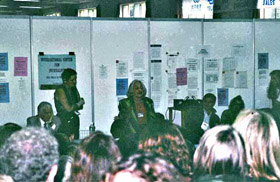|
● Why
Did the Social Movements Begin?
● Who
Worked in the Social Movements?
● What
Is a Social Movement?
● The
Civil Rights Movement
● Organizations
● Direct Action Tactics
● Changes
● The Youth Movement
/Anti-War Movement
● The Women's Movement
● Conclusion
The Civil Rights Movement
 Segregation
laws in Southern states in the US prevented black and white people
from sitting together in movie theaters, eating in the same restaurants,
drinking from the same water fountain, using the same washrooms
or riding together on buses or trains. Black and white children
could not go to the same schools, and most Negroes were not allowed
to vote. Although these segregation laws were illegal under the
14th Amendment to the United States Constitution, the US government
would not declare the Southern laws unconstitutional until there
were cases brought in federal courts. The civil rights movement
began when black people spontaneously protested segregation laws
and created organizations to make the protests successful. Long
before the students in Greensboro, North Carolina began their sit-ins,
there were many others who protested the segregation laws. Segregation
laws in Southern states in the US prevented black and white people
from sitting together in movie theaters, eating in the same restaurants,
drinking from the same water fountain, using the same washrooms
or riding together on buses or trains. Black and white children
could not go to the same schools, and most Negroes were not allowed
to vote. Although these segregation laws were illegal under the
14th Amendment to the United States Constitution, the US government
would not declare the Southern laws unconstitutional until there
were cases brought in federal courts. The civil rights movement
began when black people spontaneously protested segregation laws
and created organizations to make the protests successful. Long
before the students in Greensboro, North Carolina began their sit-ins,
there were many others who protested the segregation laws.
 |
|
Women Speak
up Their Minds
|
 The
spontaneous action of one woman, Rosa Parks, was believed to be
the true beginning of the civil rights movement, 5 years
before the Greensboro students "sit-in." The
spontaneous action of one woman, Rosa Parks, was believed to be
the true beginning of the civil rights movement, 5 years
before the Greensboro students "sit-in."
 In
1955, Rosa Parks, tired from working all day, boarded a public bus
in Montgomery, Alabama. According to Alabama law, only white people
could sit in the front of the bus. Since the back of the bus was
full, Rosa Parks sat down in an empty seat in the middle of the
bus. When the bus driver told her to get up and give her seat to
a white man, she refused to do so. Rosa Parks was tired of segregation
laws which kept black people from having the same rights as white
people. She was arrested by the police for not giving her seat to
the white man. From jail, she called the president of the National
Association for the Advancement of Colored People (NAACP)
and asked for help. In
1955, Rosa Parks, tired from working all day, boarded a public bus
in Montgomery, Alabama. According to Alabama law, only white people
could sit in the front of the bus. Since the back of the bus was
full, Rosa Parks sat down in an empty seat in the middle of the
bus. When the bus driver told her to get up and give her seat to
a white man, she refused to do so. Rosa Parks was tired of segregation
laws which kept black people from having the same rights as white
people. She was arrested by the police for not giving her seat to
the white man. From jail, she called the president of the National
Association for the Advancement of Colored People (NAACP)
and asked for help.
 NAACP
members raised money for bail
to
release
Ms
Parks from jail. They also informed other organizations about her
act of civil disobedience. Black people in Montgomery,
Alabama spontaneously began to boycott the bus system, refusing
to ride on public buses. They spread the news of the bus boycott
to church members at Sunday church services.
Ministers and other church leaders organized cars and drivers to
take Negroes to work and organized groups to walk together for protection
against violence from white racists. NAACP
members raised money for bail
to
release
Ms
Parks from jail. They also informed other organizations about her
act of civil disobedience. Black people in Montgomery,
Alabama spontaneously began to boycott the bus system, refusing
to ride on public buses. They spread the news of the bus boycott
to church members at Sunday church services.
Ministers and other church leaders organized cars and drivers to
take Negroes to work and organized groups to walk together for protection
against violence from white racists.
 From
Rosa Parks' spontaneous action of nonviolent civil disobedience,
and from the social base of Negro churches, community and political
organizations, grew support for protest against segregation. The
civil rights movement began to spread all over the South. As a result,
segregation was breaking down in the 1960s. From
Rosa Parks' spontaneous action of nonviolent civil disobedience,
and from the social base of Negro churches, community and political
organizations, grew support for protest against segregation. The
civil rights movement began to spread all over the South. As a result,
segregation was breaking down in the 1960s.
Previous Page Next
Page
|

